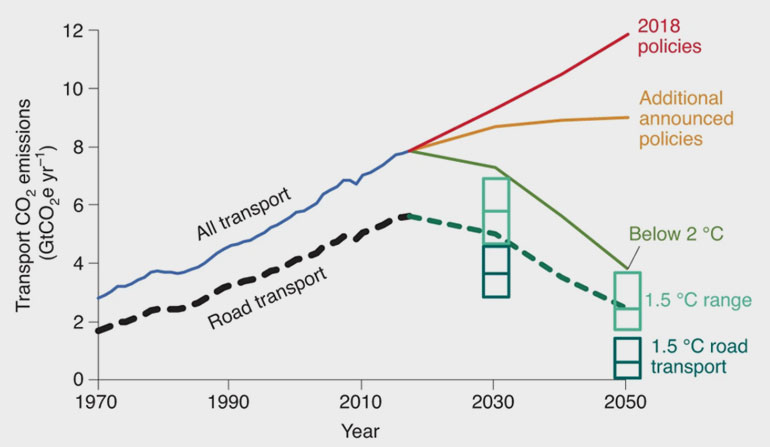Scientists demand stricter combined policy measures to mitigate CO2 from road transport
Despite new technologies and national and international target-setting, the global emissions of CO2 from road transport continue to increase.
In a study for the journal “Nature Climate Change”, three authors from Germany and Canada show that the current and recently announced policy measures are not sufficient to meet the targets in the Paris Agreement. Their conclusion is that much stricter and more integrated measures and higher carbon prices are needed to reduce emissions.
Transport is responsible for almost one quarter of all greenhouse gas emissions worldwide. 72 percent of these are due to road transport alone. The transport sector is the only sector where emissions are still increasing – even though policy measures have been taken and are planned to achieve the targets set in the Paris Agreement. Compared to 2019, emissions must decrease by 30 to 40 percent by 2030, and by 60 to 80 percent by 2050 – and should then be around zero thereafter.
A joint study by Dr. Patrick Plötz from Fraunhofer Institute for Systems and Innovation Research ISI and his Canadian colleagues Dr. Jonn Axsen (Simon Fraser University, Burnaby) and Michael Wolinetz (Navius Research, Vancouver) analyzes which national and regional policy measures can reduce the greenhouse gas emissions of road freight transport for the long term.

The main finding from their analysis of more than 150 scientific sources is that a single policy instrument will never be enough. Instead, an integrated mix of strict measures is needed. The most important measures include fleet-wide CO2 targets, mandates for zero-emission vehicles and low-carbon fuel standards. These measures can be accompanied by suitable prices and incentives.
Examples of measures that have already been successfully implemented in the US, Canada and China are binding market shares for zero-emission vehicles such as electric cars (so-called zero-emission vehicle mandates), and strict requirements for how much the emission values of all vehicles sold must decrease by a specified date. So far, the former are missing in Europe. The authors recommend zero-emission mandates for other countries as well, but emphasize that adaptations to the respective national and regional conditions are always needed, and interactions must be taken into account. Possible negative interactions include double-counting electric vehicles in the fleet emission limits and in the quotas for zero-emission vehicles.
For the national implementation of measures, for example, it was shown that a purchase premium on electric cars is only successful if relatively high and valid for at least 10 years. Norway is the prime example for such a policy as it has been promoting electric cars for 20 years with 10,000 to 15,000 euros, and these vehicles now have a market share here of more than 60 percent.
Vehicle emission standards can help to reduce greenhouse gas emissions immediately, and in the long term as well. The authors cite the European Union as being particularly ambitious here with its stipulated emission limit of 59 gram CO2 per kilometer by 2030. This fosters the switch to alternative powertrains and could lead to 40% lower emissions in 2030 compared to 2010. Strict electric vehicles quotas, however, are still missing in Europe. Since electric vehicles are so far being driven primarily by private individuals, the authors urgently recommend actively expanding strict policies such as electric vehicle quotas to freight transport as well. This could be done, for example, by stipulating a minimum proportion of electric trucks in manufacturers’ new registrations, like California recently became the first region in the world to do.
Dr. Patrick Plötz from Fraunhofer ISI emphasizes: “For long-term success, it is important to close loopholes like unrealistic test cycles and avoid unwanted effects like extra-large electric cars. This is possible through strict control and additional price incentives.”
Dr. Patrick Plötz (Fraunhofer Institute for Systems and Innovation Research ISI, Karlsruhe), Dr. Jonn Axsen (Simon Fraser University, Burnaby) and Michael Wolinetz (Navius Research, Vancouver) published the detailed results in the journal “Nature Climate Change”.
Further information
- Article in “Nature Climate Change”: Crafting strong, integrated policy mixes for deep CO2 mitigation in road transport
- Policy Brief: Much stronger policies are needed for CO2 mitigation in road transport [ PDF 0.2 MB ]
Source
Fraunhofer Institute for Systems and Innovation Research ISI 2020








